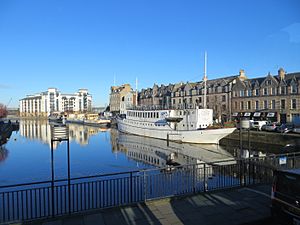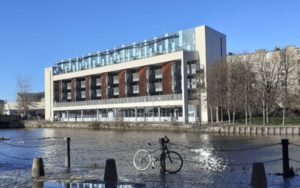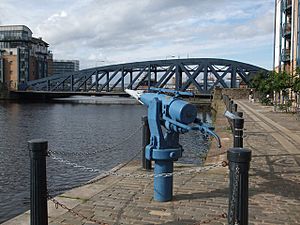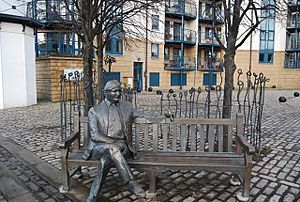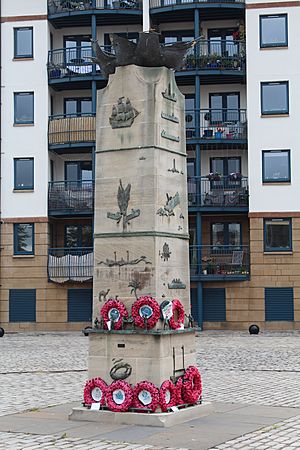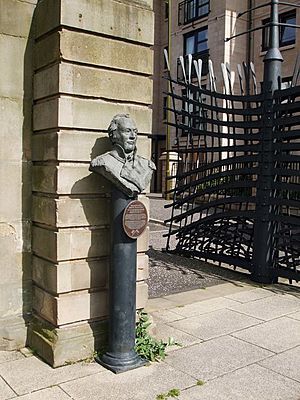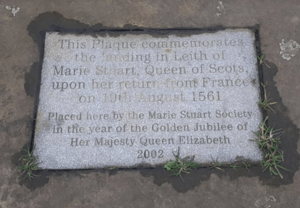The Shore, Leith facts for kids
The Shore is a famous and beautiful street in Leith, which is the harbour area of Edinburgh. It runs along the last part of the Water of Leith river before it flows into the sea through Leith Docks.
Contents
History of The Shore
The Shore has been a busy harbour area for a very long time, even since Anglo-Saxon times.
Many important people arrived here when visiting the city. These included Mary Queen of Scots in 1561 and Anne of Denmark in 1590. King Charles II arrived in 1651, and King George IV visited in 1822. Queen Victoria arrived at Leith Docks in 1842, not directly at The Shore.
In May 1544, during a war called the Rough Wooing, an English army landed in Leith. They planned to burn Edinburgh. On May 5, English ships unloaded large cannons onto the quayside at The Shore. These cannons were meant to attack Edinburgh's city gates and Edinburgh Castle.
The Leith Mutiny
In April 1779, a sad event happened at The Shore. Many lives were lost. About 70 soldiers from the 42nd and 71st Regiments were waiting to board a ship. They refused to go because they heard a rumour. They thought they would be moved to a different regiment and lose the right to wear their kilts. This rumour was not true.
About 200 soldiers from Edinburgh Castle were sent to stop the protest. The Highlanders refused to give up their weapons. Both sides were armed, and the situation quickly became violent. A Highlander tried to run away but was grabbed by a sergeant. The Highlander then used a bayonet (a knife on a rifle) to get free. Another sergeant was shot by a Highlander.
The soldiers from Edinburgh then fired their guns into the group of Highlanders. Twelve men were killed, and many more were badly hurt. The Highlanders fired back but had less ammunition. Two soldiers from Edinburgh were killed, and one was injured. A captain trying to help the injured soldier was also attacked.
The Edinburgh soldiers then moved in with their bayonets. They captured 25 Highlanders who were still alive. These survivors were sent to Edinburgh Castle. In total, between 40 and 50 lives were lost that day. The dead soldiers were buried in different churchyards. After a trial, three Highlanders were almost executed. However, they received a pardon because their regiment had been very brave in the past.
Modern Changes
The Shore was the first place in Leith to have public street lighting. Oil lamps were installed in 1771 to help people see at night. It was also the first street in Edinburgh to have electric street lights in 1895. These lights were powered by a local generating station.
Until 1969, the river water at The Shore changed with the tides. Now, because of special locks in Leith Docks, the water level is always higher. For a while, the locks were opened once a year to clean out the riverbed. This stopped when ships no longer used the inner harbour.
In the 1950s, there were plans to knock down all the buildings on The Shore. The idea was to build industrial sheds. Later, this plan changed to allow new homes. In the 1960s and 70s, many old buildings near The Shore were demolished. The Shore itself was left to decay. By 1980, only two buildings were still lived in.
For a long time, new homes could not be built near Leith Docks. This was due to safety rules because of chemicals stored nearby. This rule was removed in 1983.
Things started to change in the 1980s. People became interested in restoring old buildings. Property prices in Leith were very low. This allowed small developers to start fixing up buildings. It was hard to get loans for homes in Leith at first. The first loan for a building on The Shore was given in 1984.
As new homes appeared, The Shore became popular for restaurants and new types of pubs. At one point, Leith had three restaurants with special Michelin star awards. Now it has two: The Kitchin and Martin Wishart.
A big economic downturn in the late 1980s stopped development. But it started again in 1993. Since then, The Shore has become one of the most popular areas in the city. Many new homes have been built, including some for affordable housing.
Buildings and Structures of Note
Here are some interesting buildings and structures you can find at The Shore:
- Lamb's House – This old merchant's house from 1630 is just off The Shore. It was restored in 2012.
- Signal Tower – This building was first a windmill in 1685. It became a signal tower during the Napoleonic Wars.
- 20 Shore – You can see a preserved doorway from 1678 here.
- The King's Wark – This building was rebuilt in 1705. It was restored in 1972 and now has flats above a pub.
- Preserved Door south of Kings Wark – This doorway is from 1711.
- Malt & Hops public house – This pub dates back to 1745. It is one of the oldest pubs in Scotland.
- The Cooperage – This building was a warehouse built around 1760. It was the first warehouse in Leith to be turned into homes.
- The metal edge on the west side marks Scotland's first dry dock from 1771.
- Sandport Bridge – This bridge was built in 1780. The middle part was replaced in 1950.
- A large round iron cover on the eastern river edge shows where Scotland's first sewer flowed into the river in 1785.
- Customs House – This building was built in 1812.
- Old Ship Inn – This pub is from the 1860s. It has old stone carvings and a model ship on its front.
- Malmaison Hotel – This hotel was built in 1883 as a hostel for sailors.
- Statue of Sandy Irvine Robertson – This statue of a man sitting on a bench is at the north end. It was placed there in 1995.
- Faux lighthouse – This fake lighthouse at the north end was made in 1995. It uses parts from a larger lighthouse.
- Modern harpoon – A harpoon from the 1950s was donated in 1996. It is at the north end.
- Rostral column monument – This monument to Merchant Navy sailors was built in 2010. It is at the north end.
- Ronaldsons Wharf – This area was voted the best brownfield redevelopment in 2004.
- New pivoting dock gates – These gates were installed in 1995. They helped with the Tall Ships Race.
Lost Features of The Shore
Many things that once stood at The Shore are now gone:
- The Ramage & Ferguson shipyard was to the north-west. It closed in 1935.
- The Adam fireplace company used to bring their materials here. Their workshop was on Bernard Street.
- Catchpell House was the first Royal Tennis court in Edinburgh. It was destroyed in 1695.
- Several old warehouses on Timber Bush were destroyed in a fire in 1983.
- A group of historic buildings near Broad Wynd were knocked down around 1975.
- Robert Adam's only tenement building was at the west end of Sandport Street. It was demolished in 1978 to make a car park.
- Mary of Guise's house (from about 1530) stood on Queen Street until 1849. This area is now called Shore Place.
- Leith's first Episcopal chapel was in a building from 1516. It was on Queen Street. In 1865, it became a temperance hall.
Memorials
You can find several memorials at The Shore:
- A plaque marks where Mary Queen of Scots landed. It is set into the stone by the river.
- A bust (a statue of a head and shoulders) of Vice Admiral John Hunter is at the dock gates. He was a governor of Australia. Australia gave this bust in 1996.
- A subtle metal inlay in the ground at the south end of The Shore shows the path of the Water of Leith river. It is about 6 meters long.


